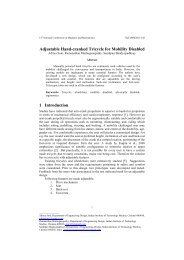Shortest path in a multiply-connected domain having curved ...
Shortest path in a multiply-connected domain having curved ...
Shortest path in a multiply-connected domain having curved ...
You also want an ePaper? Increase the reach of your titles
YUMPU automatically turns print PDFs into web optimized ePapers that Google loves.
non-<strong>in</strong>tersect<strong>in</strong>g polygonal obstacles (e.g. [14, 19]). A prom<strong>in</strong>ent approach to compute the<br />
shortest <strong>path</strong> for polygonal obstacles is via the visibility graph construction [2] as shortest<br />
<strong>path</strong> is a subset of the visibility graph.<br />
<strong>Shortest</strong> <strong>in</strong>terior <strong>path</strong> (SIP) <strong>in</strong> a <strong>curved</strong> boundary can be thought of as a comb<strong>in</strong>ation<br />
of Euclidean and geodesic, where the SIP will consist of straight l<strong>in</strong>es and arcs of <strong>curved</strong><br />
boundaries [18]. Approximat<strong>in</strong>g <strong>curved</strong> boundaries with polygons generates <strong>in</strong>accuracies <strong>in</strong><br />
SIP and is not satisfactory <strong>in</strong> general [7]. Another approach to compute SIP <strong>in</strong> a <strong>curved</strong><br />
boundary is to sample po<strong>in</strong>ts on the <strong>curved</strong> boundary [12] and then employ a typical shortest<br />
<strong>path</strong> algorithm (such as Dijkstra [1]). The accuracy will depend on the sampl<strong>in</strong>g technique<br />
used and is an approximate computation of the SIP. Algorithm for piecewise-l<strong>in</strong>ear boundaries<br />
such [11] has also been extended to <strong>curved</strong> boundary us<strong>in</strong>g “funnels” <strong>in</strong> [13] assum<strong>in</strong>g the<br />
<strong>in</strong>put (<strong>curved</strong> boundary) is already triangulated. Numerical approximation of shortest <strong>path</strong><br />
<strong>in</strong> <strong>curved</strong> obstacles us<strong>in</strong>g fast-sweep<strong>in</strong>g of Eikonal equations [22] and grid-based approach has<br />
been presented <strong>in</strong> [17].<br />
Very few algorithms have handled the computation of SIP of <strong>curved</strong> boundary without<br />
approximat<strong>in</strong>g with polygons or sample po<strong>in</strong>ts, albeit theoretically. Comput<strong>in</strong>g visibility<br />
graph based on greedy approach pseudo-triangulation for a set of non-<strong>in</strong>tersect<strong>in</strong>g convex<br />
<strong>curved</strong> objects has been presented [16]. A similar approach for convex curves that <strong>in</strong>tersect<br />
transversely has been given <strong>in</strong> [5].<br />
For arbitrarily shape <strong>curved</strong> boundary (not just convex), Bourg<strong>in</strong> and Howe [3] presented<br />
an algorithm us<strong>in</strong>g str<strong>in</strong>g formulation on the <strong>in</strong>tersection of the l<strong>in</strong>e connect<strong>in</strong>g the start and<br />
end po<strong>in</strong>ts with the <strong>curved</strong> boundary. Based on the maximal distance of the curve from the<br />
l<strong>in</strong>e, different cases are del<strong>in</strong>eated to f<strong>in</strong>d the po<strong>in</strong>ts on the curve that belong to the SIP.<br />
Fabel [10] has presented an algorithm for comput<strong>in</strong>g the shortest arcs <strong>in</strong> a closed planar disk.<br />
Both [3] and [10] are theoretical descriptions and no implementation results are provided.<br />
An algorithm with implementation results for simply-<strong>connected</strong> arbitrarily shaped <strong>curved</strong><br />
boundary has been presented <strong>in</strong> [18] us<strong>in</strong>g tangent computation and region check. The major<br />
idea <strong>in</strong> comput<strong>in</strong>g the SIP of <strong>curved</strong> boundaries [3, 10, 18] is to avoid comput<strong>in</strong>g visibility<br />
graph through identify<strong>in</strong>g potential straight l<strong>in</strong>es/arcs of the curves us<strong>in</strong>g strategies such as<br />
maximal distance [3] , region check [18] etc.<br />
To the best of our knowledge, no known algorithm with implementation results is available<br />
for arbitrarily shape <strong>curved</strong> boundary of a <strong>multiply</strong>-<strong>connected</strong> doma<strong>in</strong> (MCD). In this paper,<br />
the aim is to f<strong>in</strong>d the shortest <strong>in</strong>terior <strong>path</strong> (SIP) of a MCD hav<strong>in</strong>g <strong>curved</strong> boundaries,<br />
extend<strong>in</strong>g the algorithm presented <strong>in</strong> [18], us<strong>in</strong>g the basic idea of tangent computation. All<br />
the possible <strong>path</strong>s are directly identified dur<strong>in</strong>g the computation effectively elim<strong>in</strong>at<strong>in</strong>g the<br />
use of algorithms such as Dijkstra. SIP is then identified from the set of <strong>path</strong>s. The follow<strong>in</strong>g<br />
are the key differences from [18].<br />
• In case of simply-<strong>connected</strong> doma<strong>in</strong> (SCD) [18], the focus was on comput<strong>in</strong>g the SIP<br />
itself, s<strong>in</strong>ce SIP was unique. As there will be number of <strong>path</strong>s that could contribute<br />
towards SIP <strong>in</strong> the MCD, <strong>in</strong> this paper, the focus is on elim<strong>in</strong>at<strong>in</strong>g a <strong>path</strong> that will not<br />
play a role <strong>in</strong> the set of potential <strong>path</strong>s. Lemma 3 <strong>in</strong> the paper <strong>in</strong>dicates the <strong>in</strong>teraction<br />
that a <strong>path</strong> can have and the cases for which the <strong>path</strong> will cease to exist.<br />
• In [18], l<strong>in</strong>e connect<strong>in</strong>g S and E was used to divide the boundary curve <strong>in</strong>to two portions.<br />
As such a division is not possible <strong>in</strong> <strong>multiply</strong>-<strong>connected</strong> doma<strong>in</strong> (MCD), Lemma 4 <strong>in</strong> the<br />
2




